Server-side ads insertion in live streaming is a pivotal technology that revolutionizes the landscape of online advertising within streaming platforms. Server-side ads insertion involves the dynamic insertion of advertisements into live streaming content at the server level, rather than relying on client-side mechanisms. This means that ads are seamlessly integrated into the streaming experience without relying on the viewer’s device or player.
For streaming businesses, server-side ads insertion offers a multitude of advantages. Firstly, it ensures a consistent and uninterrupted viewing experience for the audience by minimizing buffering and low latency live streaming issues often associated with client-side ad insertion. By handling ad insertion at the server level, streaming platforms can optimize ad delivery based on real-time viewer data and network conditions, thereby enhancing overall stream quality and user satisfaction.
Moreover, server-side ads insertion enables targeted and personalized advertising, allowing advertisers to deliver relevant ads to specific audience segments based on demographics, viewing behavior, and other contextual factors. This targeted approach not only maximizes the effectiveness of ad campaigns but also enhances the overall user experience by presenting ads that are more likely to resonate with viewers.
But there’s more. And in this blog, we will walk you through all you need to know about Server Side Ads Insertion. So, let’s get started!
What Is Server Side Ads Insertion?
Server-side ad insertion is a technology used in online streaming platforms to dynamically integrate advertisements into live or on-demand content at the server level. Unlike client-side insertion, which relies on the viewer’s device or player to manage ad delivery, server-side insertion inserts ads directly into the stream before it reaches the viewer’s device.
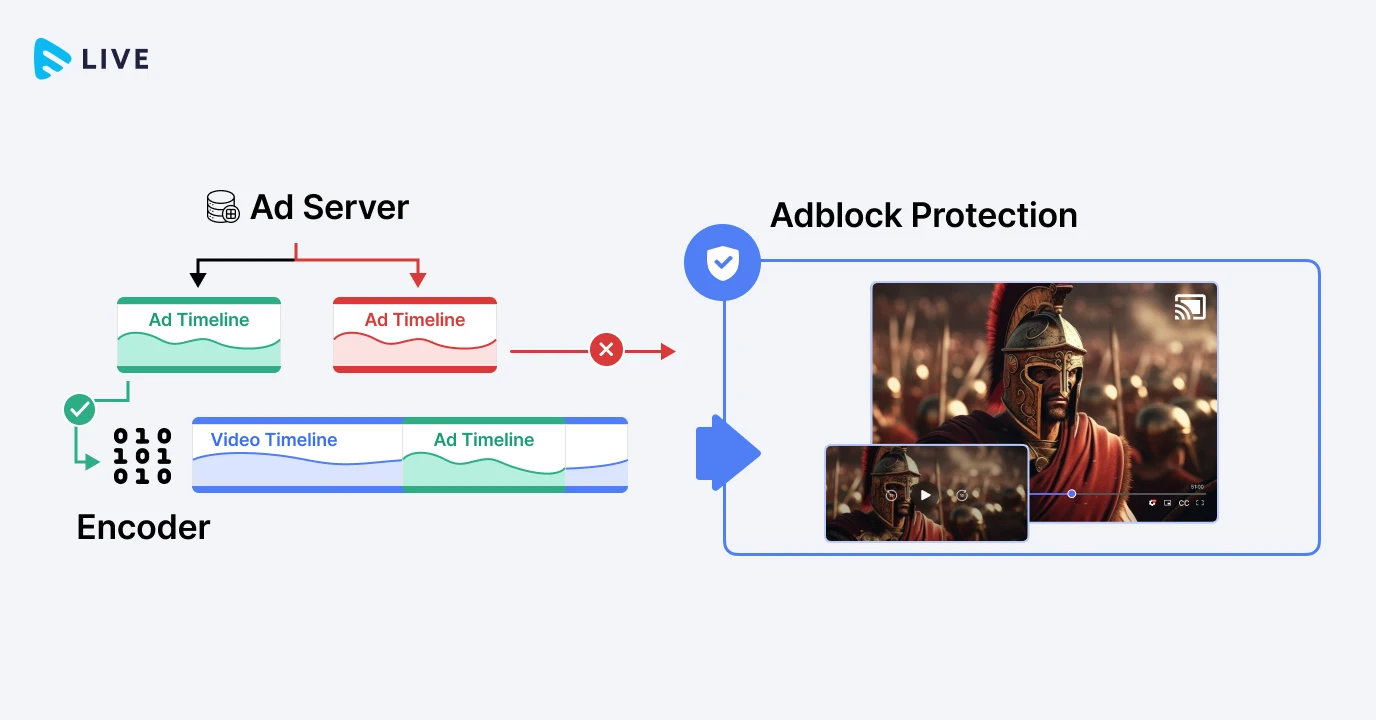
In server-side ads insertion, the streaming server identifies appropriate ad placements within the content and seamlessly integrates advertisements into the stream in real-time. This method allows for smoother transitions between content and ads, minimizing disruptions to the viewer experience.
One of the key benefits of server-side ads insertion is its ability to optimize ad delivery based on factors such as audience demographics, viewing behavior, and network conditions. By managing ad insertion at the server level, streaming platforms can ensure that ads are delivered efficiently and effectively to target audiences.
The Advantages of Server Side Ads Insertion in Live Streaming
1. Enhanced Viewer Experience
One of the primary advantages of server-side ads insertion is its ability to enhance the viewer experience. By inserting ads at the server level rather than relying on client-side mechanisms, streaming platforms can ensure a seamless and uninterrupted viewing experience for their audience.
Since ads are integrated directly into the stream before reaching the viewer’s device, there is minimal buffering or latency associated with ad playback, leading to smoother transitions between content and advertisements.
Moreover, server-side ads insertion allows streaming platforms to optimize ad delivery based on real-time viewer data and network conditions. This means that ads can be dynamically inserted at strategic points within the content without disrupting the viewing experience. By delivering targeted and relevant advertisements to viewers, streaming platforms can increase engagement and satisfaction while minimizing viewer drop-off rates.
2. Seamless Ad Integration
Another advantage of server-side ads insertion is its ability to seamlessly integrate advertisements into live streaming content. Unlike client-side insertion, which may result in disjointed ad experiences or ad-blocking behaviors, server-side insertion ensures that ads are seamlessly integrated into the stream, maintaining the flow and continuity of the viewing experience.
With server-side insertion, streaming platforms have greater control over ad placement and frequency, allowing them to deliver ads in a manner that complements the viewing experience rather than detracting from it. Additionally, server-side insertion enables more precise targeting and personalization of advertisements, ensuring that viewers receive ads that are relevant to their interests and preferences.
Furthermore, server-side insertion offers benefits for advertisers by providing enhanced ad measurement and analytics capabilities. By tracking ad impressions, click-through rates, and other performance metrics in real-time, advertisers can gain valuable insights into the effectiveness of their ad campaigns and make data-driven decisions to optimize their advertising strategies.
3. Targeted Advertising Capabilities
Server-side ads insertion in live streaming enables powerful targeted advertising capabilities that revolutionize the way ads are delivered to viewers. Unlike traditional broadcast methods where ads are broadcasted to a broad audience without much targeting, server-side insertion leverages data analytics and viewer insights to deliver highly relevant and personalized ads.
By analyzing viewer demographics, viewing behavior, and preferences, streaming platforms can tailor ads to specific audience segments, ensuring that viewers receive advertisements that resonate with their interests and preferences. This targeted approach not only enhances the effectiveness of ad campaigns but also maximizes viewer engagement and ad recall.
Moreover, server-side insertion allows advertisers to implement advanced targeting parameters, such as geographic location, device type, and browsing history, to further refine their ad targeting strategies. This level of granularity enables advertisers to reach highly specific audience segments with precision, resulting in higher conversion rates and return on investment.
Additionally, server-side insertion facilitates the integration of interactive and dynamic ad formats, such as interactive overlays, companion banners, and personalized messaging, to enhance viewer engagement and interactivity. By delivering ads that are tailored to the individual viewer’s interests and preferences, streaming platforms can create a more immersive and personalized ad experience that drives higher engagement and brand loyalty.
4. Improved Ad Revenue Potential
Server-side ads insertion offers streaming platforms and content creators the opportunity to unlock new revenue streams and maximize ad revenue potential. By leveraging advanced ad targeting capabilities and analytics, streaming platforms can optimize ad placement and frequency to maximize ad impressions and revenue generation.
Furthermore, server-side insertion enables streaming platforms to implement programmatic advertising technologies, such as real-time bidding and ad exchanges, to automate the buying and selling of ad inventory. This automation streamlines the ad sales process, reduces operational costs, and enables streaming platforms to scale their advertising operations more efficiently.
Moreover, server-side insertion provides streaming platforms with greater control and flexibility over their advertising inventory, allowing them to adjust ad pricing, targeting parameters, and delivery methods to maximize revenue potential. By implementing dynamic pricing models and auction-based pricing mechanisms, streaming platforms can optimize ad revenue yield and monetize their content more effectively.
5. Scalability and Flexibility
Server-side ads insertion offers scalability and flexibility for streaming platforms to adapt to evolving advertising trends and consumer preferences. By centralizing ad management and delivery functions at the server level, streaming platforms can scale their advertising operations more efficiently and cost-effectively.
Moreover, server-side insertion enables streaming platforms to integrate with third-party ad serving platforms and ad networks, allowing them to access a broader range of advertisers and ad inventory. This integration enhances the flexibility of streaming platforms to monetize their content through a variety of advertising formats and channels.
Furthermore, server-side insertion facilitates the implementation of advanced ad targeting and personalization features, such as contextual targeting, audience segmentation, and predictive analytics, to enhance ad relevance and effectiveness. By leveraging machine learning and artificial intelligence algorithms, streaming platforms can analyze vast amounts of viewer data to identify trends, patterns, and insights that inform more targeted and personalized ad campaigns.
A Guide To Server Side Ads Insertion in Live Streaming
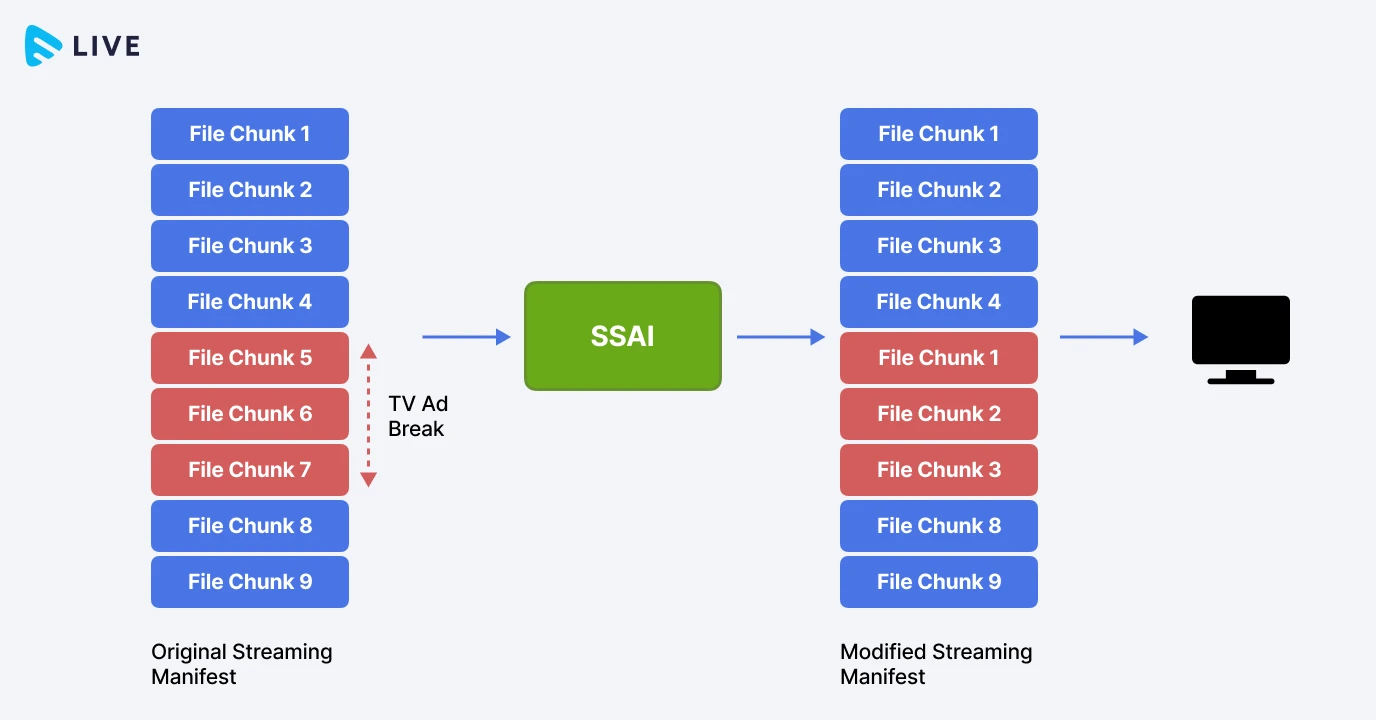
1. How Server-Side Ad Insertion (SSAI) Works?
SSAI operates by intercepting the video stream at the server level and inserting ads into the stream before delivering it to the viewer’s device. The process involves several key steps:
- Content Ingestion: The streaming platform ingests the live or on-demand content, which includes the primary video stream and metadata.
- Ad Decisioning: Before the content is streamed to the viewer, the SSAI system determines when and where ads should be inserted based on various factors such as viewer demographics, content genre, and ad campaign parameters. This process, known as ad decisioning, involves selecting the most relevant ads from a pool of available inventory.
- Ad Stitching: Once the ad slots are identified, the SSAI system dynamically stitches the ads into the content stream. This involves splicing the ad segments seamlessly into the primary video stream to create a cohesive viewing experience.
- Content Delivery: The stitched content, including both the primary content and inserted ads, is then delivered to the viewer’s device for playback. From the viewer’s perspective, the ads appear as an integral part of the streaming content, rather than separate interruptions.
- Tracking and Reporting: Throughout the process, the SSAI system tracks various metrics such as ad impressions, click-through rates, and viewer engagement to provide advertisers and content creators with insights into ad performance and audience behavior.
SSAI offers several key advantages over client-side ad insertion methods:
- Consistent Viewing Experience: By handling ad insertion at the server level, SSAI ensures a consistent viewing experience across different devices and platforms. Viewers are less likely to encounter buffering or playback issues associated with client-side ad insertion.
- Improved Ad Targeting: SSAI enables more precise targeting of ads based on viewer demographics, behavior, and preferences. Advertisers can deliver personalized ads to specific audience segments, increasing the relevance and effectiveness of their campaigns.
- Reduced Ad Blocking: Since ads are integrated into the content stream at the server level, they are less susceptible to ad-blocking software or browser extensions that may disrupt client-side ad insertion methods.
2. Implementing SSAI: Key Components
Implementing SSAI involves a series of key components and processes that enable streaming platforms to deliver targeted ads while ensuring a consistent viewing experience for the audience.
Key Components of SSAI Implementation
- Content Ingestion and Encoding: Content ingestion is the process of acquiring live or on-demand video content from various sources, such as cameras, encoders, or content delivery networks (CDNs). The first step in SSAI implementation involves ingesting the primary content stream, which includes the main video content that viewers will watch. Once the content is ingested, it needs to be encoded into various formats and bitrates to accommodate different devices and network conditions. This encoding process ensures that the content can be efficiently streamed to viewers across different platforms and devices.
- Ad Decisioning System: The ad decisioning system is a crucial component of SSAI that determines which ads to insert into the content stream and when to insert them. This system relies on algorithms and rules defined by the streaming platform or ad network to select ads that are relevant to the viewer and maximize revenue potential. Ad decisioning involves considering various factors such as viewer demographics, content genre, ad campaign objectives, and real-time bidding data to make informed decisions about ad placement and targeting.
- Ad Stitching Engine: The ad stitching engine is responsible for seamlessly integrating ads into the content stream before delivering it to the viewer’s device. This process, known as ad stitching, involves dynamically splicing ad segments into the primary content stream in real-time. The ad stitching engine must ensure that ads are inserted at appropriate points in the content stream, such as natural breaks or transitions, to minimize disruptions to the viewing experience. It also needs to handle ad transitions smoothly to avoid buffering or playback issues.
- Content Delivery Network (CDN): A Content Delivery Network (CDN) is a network of servers distributed geographically to deliver content to users more efficiently. In the context of SSAI implementation, the CDN plays a crucial role in delivering both the primary content stream and the inserted ads to viewers in a timely and reliable manner. The CDN helps optimize content delivery by caching and distributing content across multiple edge servers located closer to the viewer, reducing latency and improving streaming performance. It also provides scalability and redundancy to handle fluctuations in viewer traffic and ensure high availability of content.
- Player Integration: Player integration involves incorporating SSAI capabilities into the video player used by viewers to stream content. The player must be compatible with SSAI protocols and APIs to seamlessly receive and playback the content stream with inserted ads. The player needs to handle ad cues and markers provided by the ad stitching engine to synchronize ad playback with the primary content stream. It also needs to support adaptive bitrate streaming and other advanced features to deliver a high-quality viewing experience across different devices and network conditions.
- Ad Tracking and Reporting: Ad tracking and reporting are essential components of SSAI implementation that provide advertisers and content creators with insights into ad performance and viewer engagement. The system tracks various metrics such as ad impressions, click-through rates, completion rates, and viewer interactions to measure the effectiveness of ad campaigns. Ad tracking and reporting enable advertisers to evaluate the return on investment (ROI) of their ad spend and optimize their targeting and messaging strategies based on real-time feedback. It also allows content creators to analyze viewer behavior and preferences to tailor content and ad experiences more effectively.
SSAI vs Client-Side Insertion
Below is an in-depth comparison outlining the differences between Server-Side Ads Insertion (SSAI) and Client-Side Insertion:
Feature | Server-Side Ads Insertion (SSAI) | Client-Side Ads Insertion |
Ads Integration | Ads are integrated into the content stream at the server level before delivery to the viewer’s device. | Ads are inserted into the content stream at the client’s device or player. |
Viewing Experience | Provides a seamless and uninterrupted viewing experience with minimal buffering or latency. | May result in buffering or delays as ads are loaded separately from the content. |
Ad Blocking | Less susceptible to ad-blocking software or browser extensions since ads are integrated into the content stream. | More susceptible to ad-blocking software or browser extensions since ads are loaded separately. |
Ad Targeting | Offers advanced ad targeting capabilities based on viewer demographics, behavior, and preferences. | Limited ad targeting capabilities based on device or browser information. |
Ad Personalization | Enables personalized ad experiences with targeted ads tailored to individual viewer interests. | Limited ability to deliver personalized ads due to constraints at the client-side. |
Ad Measurement | Provides robust ad measurement and reporting capabilities, tracking metrics such as impressions, click-through rates, and completion rates. | Limited ad measurement and reporting capabilities, often relying on client-side tracking. |
Content Control | Offers greater control over ad placements and frequency, allowing for dynamic ad insertion and optimization. | Limited control over ad placements and frequency, with less flexibility for optimization. |
Scalability | Offers scalability and flexibility to handle large volumes of ad impressions and viewership. | May face scalability challenges, especially during peak traffic periods or high-demand events. |
Integration Complexity | Requires integration with ad decisioning systems, ad stitching engines, CDNs, and player frameworks. | Relatively simpler integration with client-side ad networks and player SDKs. |
Monetization Potential | Maximizes ad revenue potential by delivering targeted ads and optimizing ad placements. | May result in lower ad revenue potential due to limitations in targeting and measurement. |
Best Practices for Server Side Ads Insertion in Live Streaming
1. Advanced Ad Targeting and Personalization
Implementing advanced ad targeting and personalization techniques is essential for maximizing the effectiveness of SSAI. By leveraging viewer data, demographics, and behavioral insights, streaming platforms can deliver targeted ads that are relevant to individual viewer interests and preferences.
- Utilize Viewer Data: Collect and analyze viewer data to understand audience demographics, interests, and behavior patterns.
- Segmentation: Divide viewers into specific audience segments based on demographic characteristics, viewing history, and engagement metrics.
- Dynamic Ad Insertion: Use dynamic ad insertion techniques to serve personalized ads based on viewer profiles and preferences.
- A/B Testing: Conduct A/B testing to optimize ad targeting strategies and measure the effectiveness of different ad creatives and messaging.
2. Seamless Integration and Playback
Ensuring seamless integration and playback of ads is crucial for maintaining a positive viewer experience and minimizing disruptions during content consumption. Seamless integration involves synchronizing ad insertion with the content stream to create a cohesive viewing experience for viewers.
- Ad Stitching: Use advanced ad stitching techniques to seamlessly integrate ads into the content stream without buffering or playback interruptions.
- Ad Cue Points: Implement accurate ad cue points to ensure that ads are inserted at natural breaks or transitions in the content.
- Streamlining Transitions: Minimize transitions between content and ads to create a seamless viewing experience for viewers.
- Quality Control: Regularly monitor and optimize ad insertion processes to maintain high-quality streaming and playback performance.
3. Ad Measurement and Analytics
Implementing robust ad measurement and analytics practices is essential for tracking ad performance, optimizing ad campaigns, and maximizing ad revenue potential. By leveraging ad measurement data, streaming platforms can gain valuable insights into viewer engagement, ad effectiveness, and campaign ROI.
- Ad Performance Metrics: Track key ad performance metrics such as ad impressions, click-through rates, completion rates, and viewability.
- Audience Insights: Analyze viewer engagement metrics to understand audience behavior, preferences, and ad interactions.
- Attribution Modeling: Use attribution modeling techniques to measure the impact of ad campaigns on viewer actions and conversions.
- Real-Time Reporting: Implement real-time reporting and analytics dashboards to monitor ad performance and make data-driven decisions in real-time.
4. Ad Monetization Strategies
Developing effective ad monetization strategies is critical for maximizing ad revenue potential and optimizing the overall monetization of streaming content. By implementing targeted ad placements, optimizing ad load, and leveraging programmatic advertising technologies, streaming platforms can maximize ad revenue while maintaining a positive viewer experience.
- Targeted Ad Placements: Identify optimal ad placements within the content stream to maximize viewer engagement and ad revenue potential.
- Optimized Ad Load: Strike a balance between ad frequency and viewer experience by optimizing ad load and pacing.
- Programmatic Advertising: Embrace programmatic advertising technologies to automate the buying and selling of ad inventory and maximize revenue yield.
- Ad Format Innovation: Experiment with new ad formats and interactive ad experiences to engage viewers and drive higher ad performance.
5. Compliance and Privacy Considerations
Ensuring compliance with industry regulations and privacy standards is essential for maintaining trust and transparency with viewers and advertisers. Live Streaming platforms must adhere to data protection regulations, privacy policies, and advertising standards to safeguard viewer privacy and ensure ethical ad practices.
- GDPR Compliance: Ensure compliance with the General Data Protection Regulation (GDPR) and other data protection regulations governing the collection and use of viewer data.
- Privacy Policies: Clearly communicate privacy policies and data usage practices to viewers and advertisers to foster transparency and trust.
- Ad Transparency: Disclose sponsored content and native advertising to viewers in accordance with advertising standards and guidelines.
- Ethical Ad Practices: Adhere to ethical advertising practices and industry standards to prevent deceptive or misleading advertising practices.
The Bottom Line
Undoubtedly, Server-Side Ads Insertion (SSAI) stands as a crucial technology for live streaming businesses, offering enhanced viewer experience, targeted advertising capabilities, and increased revenue potential. By seamlessly integrating ads into the content stream at the server level, SSAI ensures a smooth and uninterrupted viewing experience for audiences while providing streaming platforms with advanced ad targeting, measurement, and monetization options.
Platforms like Muvi Live exemplify the importance of advanced technologies like SSAI in the live streaming industry. Muvi Live provides enterprise-grade features for delivering uninterrupted live streams securely to millions of viewers and helps businesses achieve live stream success by leveraging advanced features and infrastructure to engage their audiences and maximize their revenue potential in the competitive live streaming landscape.
Start for free today to explore more!

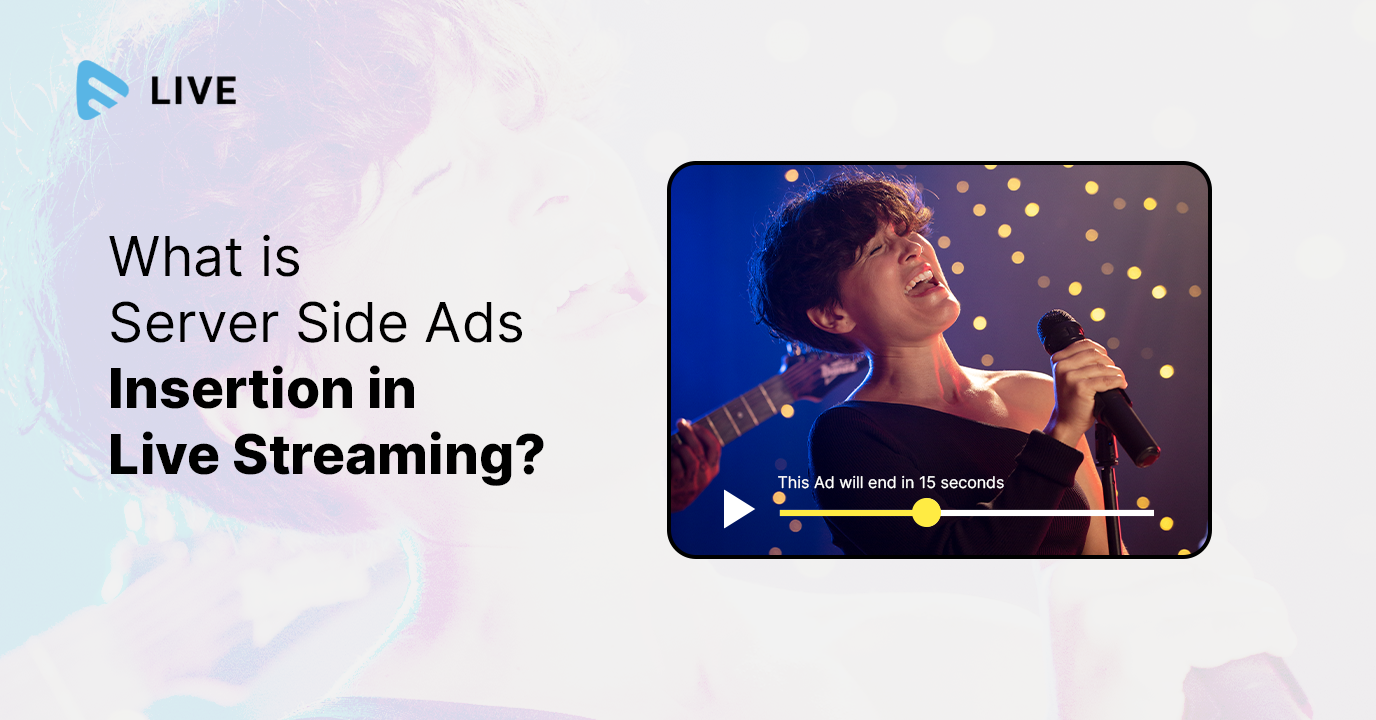











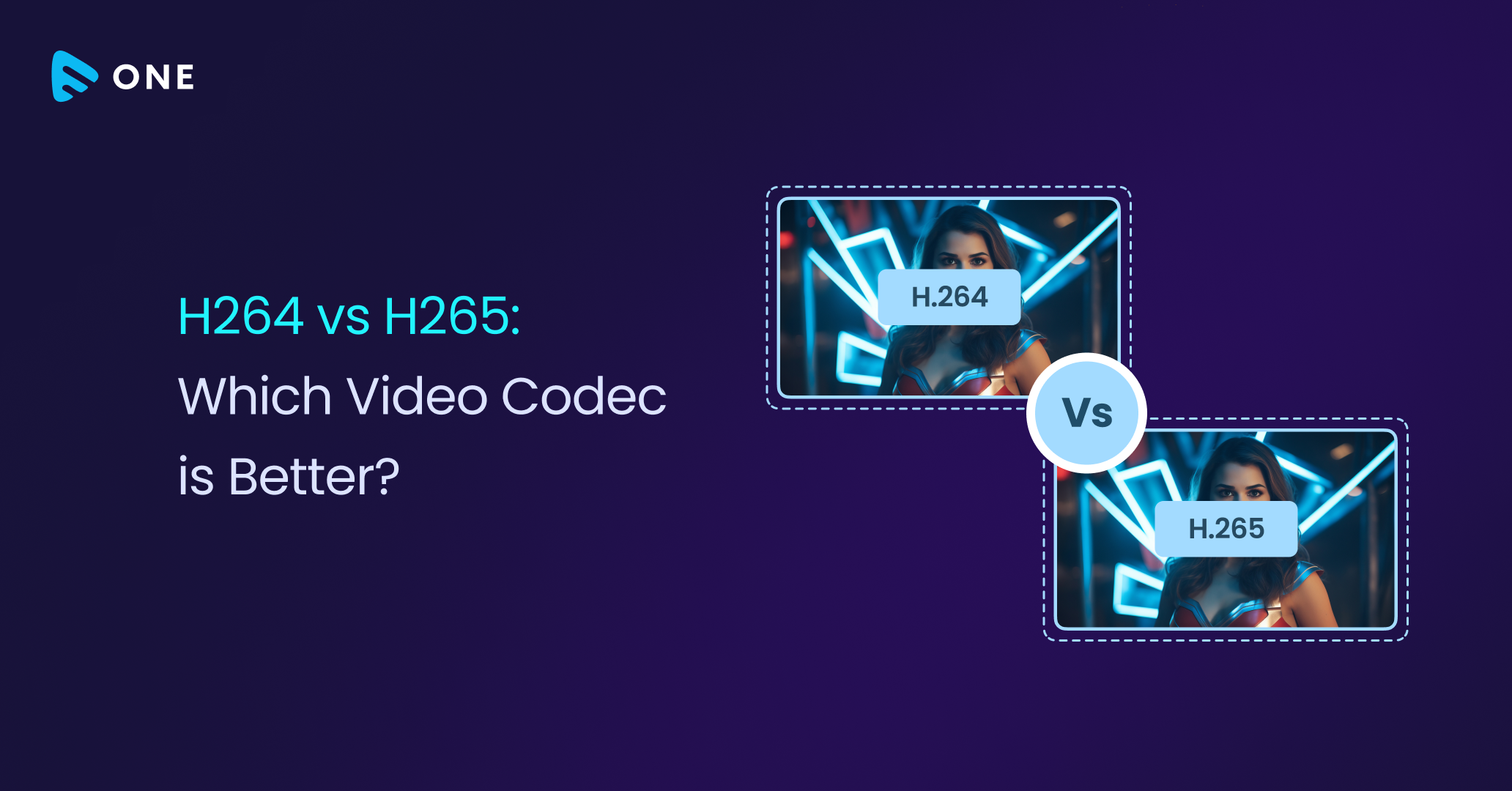

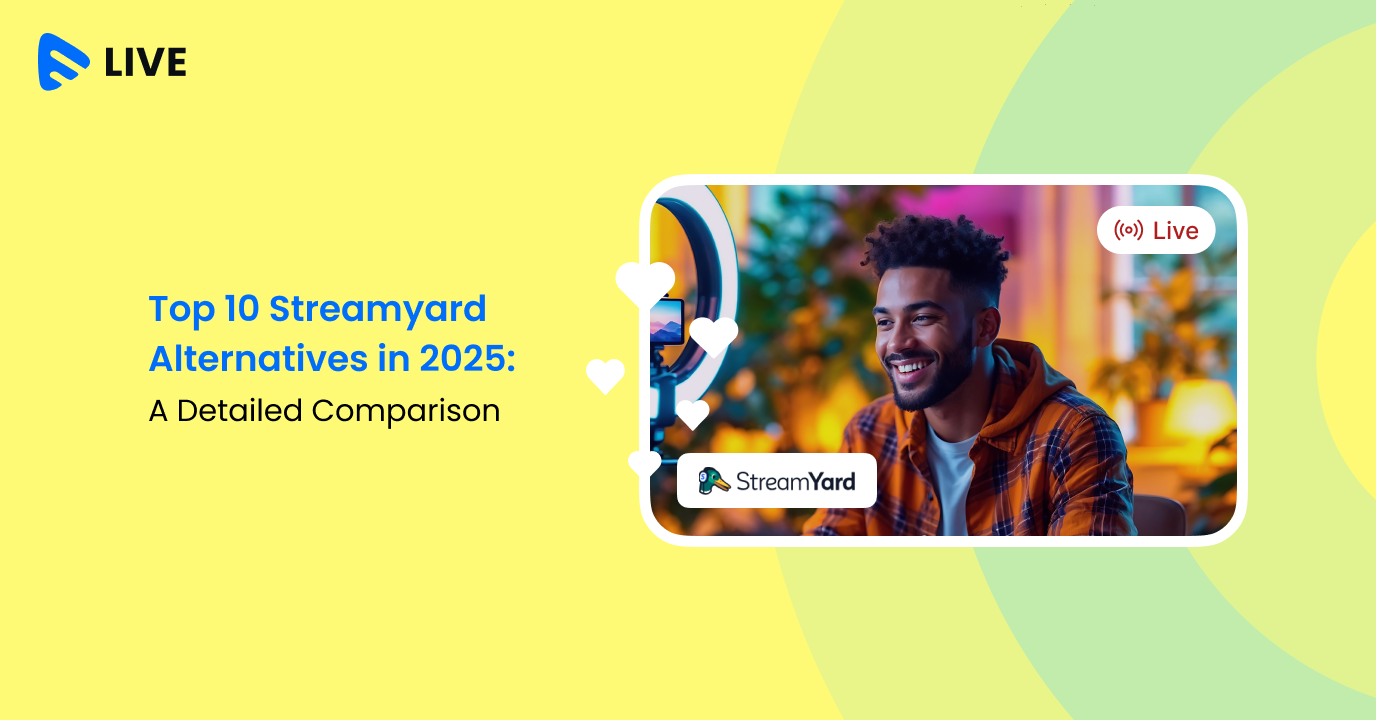



Add your comment